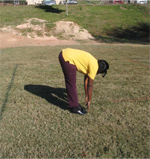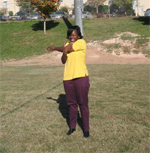Key Components of
Physical-e-Fit
Starting a Walking Program
Taking part in physical activity for as little as 30 minutes a day can lower your risk for developing many health conditions. Walking is an activity that many can enjoy because the time and intensity can be adjusted to meet the needs of most everyone’s ability level. It can also be enjoyed alone, with a friend or partner, or as part of a group. Walking is also low risk compared to other activities, and starting a walking program is relatively easy. Walking was one of the core activities used in Physical-e-Fit. Churches were encouraged to develop walking programs to support members’ physical activity goals.
Example of a Walking Program
Sometimes all we need to get started is a push in the right direction. By knowing where to start, we have taken that first step in making healthy changes in our lives. Below is an example of a walking program that you can use as you start toward your goal of being more physically active. This is a great way to start off slowly with a walking program. Try to do this program at least 3 times a week, and gradually move up to 5 times a week. If you walk less than 3 times a week, increase the brisk walking time more slowly. (Source: National Institute of Diabetes and Digestive and Kidney Disease)
Week |
Warm-up time |
Fast walk time |
Cool down time |
Total time |
1 |
Walk slowly 5 minutes |
Walk briskly 5 minutes |
Walk slowly 5 minutes |
15 minutes |
2 |
Walk slowly 5 minutes |
Walk briskly 8 minutes |
Walk slowly 5 minutes |
18 minutes |
3 |
Walk slowly 5 minutes |
Walk briskly 11 minutes |
Walk slowly 5 minutes |
21 minutes |
4 |
Walk slowly 5 minutes |
Walk briskly 14 minutes |
Walk slowly 5 minutes |
24 minutes |
5 |
Walk slowly 5 minutes |
Walk briskly 17 minutes |
Walk slowly 5 minutes |
27 minutes |
6 |
Walk slowly 5 minutes |
Walk briskly 20 minutes |
Walk slowly 5 minutes |
30 minutes |
7 |
Walk slowly 5 minutes |
Walk briskly 23 minutes |
Walk slowly 5 minutes |
33 minutes |
8 |
Walk slowly 5 minutes |
Walk briskly 26 minutes |
Walk slowly 5 minutes |
36 minutes |
9 and beyond |
Walk slowly 5 minutes |
Walk briskly 30 minutes |
Walk slowly 5 minutes |
40 minutes |
To download a brochure that includes this walking program and more, click here. This brochure can be printed, copied, and shared with members of your congregation.
The following materials were used in the Physical-e-Fit program to assess readiness for physical activity, track individual participation, and develop a Footsteps for Faith walking club. Click on each link below to learn more about starting a walking program with your church or group!
Developing Walking Clubs (pdf)
Footsteps for Faith: Getting Started (pdf)
Footsteps for Faith: Contest Rules (pdf)
Footsteps for Faith: Participant Log (pdf)
Footsteps for Faith: Church Log (pdf)
Walking Club Tracking List (pdf)
Physical Activity Readiness Questionnaire (pdf)
Walk a Mile in Your Own Shoes - Columbia (pdf)
Monthly Walking Log (pdf)
Walking Club Roster (pdf)
Warm up and Cool Down Essentials
Before you get started with walking or taking part in any physical activity program, learning the basics of warming up and cooling down is important. Warming up helps to increase your heart rate, get blood flowing to your muscles, warm-up your joints, and decrease the chance of an injury. You can do lots of things to warm-up, like take a slow walk, climb some stairs, march in place, or do a less intense version of your planned physical activity.
People often forget about their cool-down, but it is just as important as a warm-up! Cooling down helps to bring your heart rate and blood pressure back down, prevents blood pooling, and safely brings your body back to a resting state. Cool-down activities are the same intensity as warm-up activities. Including some light stretching can also help to reduce stiffness and prevent sore muscles. When stretching, try to hold each stretch for 30 seconds and be sure not to bounce while holding the stretches.
Here are some stretches you can try.
 |
Lower Leg Stretch |
 |
Thigh Stretch |
 |
Hamstring Stretch |
 |
Shoulder Stretch |
Pedometer Basics

What is a pedometer? Pedometer photo is located in Images folder: pedometer
A pedometer, or step-counter, is a small device that counts how many steps you take.
Why should I use a pedometer?
Often, we have no idea how active we are during the day, but when we use a pedometer we get a good idea of just how active (or inactive) we are.
How can I use my pedometer to set goals?
Some studies have shown that reaching 10,000 steps a day can lead to a healthier lifestyle. But for many of us, that milestone seems a long way off. When you first start to wear your pedometer, record your daily steps for one week. This will give you an idea of where you are, and where you need to go. Set short-term goals for yourself to increase your steps by 500 or 1000 for each day during the following week. Keep increasing your steps on a weekly basis until you reach your long term goal, whether it is 10,000 steps a day or some other achievement you'd like to make.
What should I look for when I buy a pedometer?
A quality pedometer usually costs at least $15, and can range in price up to $30 or $40. You need something that is lightweight, easy to read, and simple to use. Though some pedometers come with extra features like calorie counters or activity timers, these features are often not accurate, and are not worth the extra money.
Examples of high quality pedometers
We have listed some examples of high-quality pedometers. Many of them can be purchased online at sites like amazon.com. At some sites, you can also get a discount if you purchase more than one, so ask if others in your church want to go in on an order to save money!
- Yamax Digiwalker (a basic model like SW-200 is fine)
- Walk 4 Life Pedometers (the single function pedometers are fine)
- Omron Pedometers (some of these models have a usb connector so you can upload all of your information to your computer and track progress over time)
- Accusplit Pedometers (basic model is fine)
Remember that multiple features (like distance, calories, etc) are not really necessary, require you to input information like your stride length, and may not always be accurate. So a simple pedometer that just tracks steps is great and less expensive!